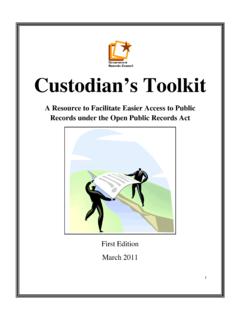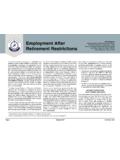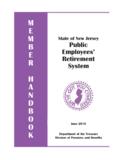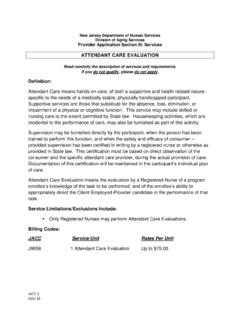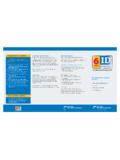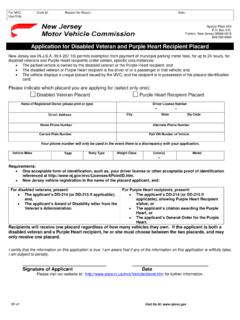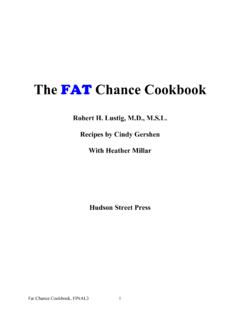Transcription of Exercise Guidelines for Osteoporosis and Osteopenia
1 WHY Exercise ? Exercise can decrease bone loss, increasebone density, and reduce the risk offractures. Choosing the wrong exercisecan be harmful and should be avoided. A safe and effective Exercise programincludes weight-bearing, resistance,postural, and balance TIPS:Check with your health care providerbefore you begin any Exercise program. Avoid exercises that require you to bend your spine forward (toe touches, sit-ups, or crunches). Theseexercises can increase the incidence of spinal fractures. Avoid exercises involving excessive twisting (windmilltoe touches). This movement puts too much force onyour spine. Avoid any Exercise that causes or increases pain. Stop exercising if you feel dizzy or short of breath. Never hold your breath while exercising. Keep your back straight and your weight over the centerof your feet while exercising.
2 Wear shoes with good cushioning and exercises transmit the weight of thebody through the bones working against gravity. Walking,dancing, and hiking are examples. The goal is to work up to45 minutes or more per sesssion. Perform at least 3 to 5times per up by walking at a slow pace for 5 minutes. Increasespeed gradually to a brisk pace. Walk at a speed you canmaintain for at least 20 minutes. To check your intensity,make sure you can carry on a conversation while work up to a 45-minute walk. Cool down witha 5-minute slow walk. Perform gentle stretches after exercisesgenerate muscle tension on thebones to strengthen muscles and stimulate bones to growstronger. Examples are free weights, Exercise machines andresistance bands. Start exercising without weights.
3 Beginwith 1 set of 8 to 10 repetitions of each Exercise increasinggradually to 2 or 3 sets. When that becomes easy, add 1 at a time. Perform 2 to 3 times a week but not onconsecutive Em UpSit or stand, bringing arms into a W position without hunching shoulders. If sitting, place feet on the floor withknees apart. If standing, tighten lowerabdominal muscles and keep knees soft(not locked). Bring arms backward to a comfortable position and pinchshoulder blades together. Slowly returnto the starting position. Work up to 10 repetitions. When you can do this 10 times withoutdifficulty, add 1-lb. weights to each hand or wrist. Increaseweight gradually. Postural exercisesstretch and strengthen muscles toimprove posture. They decrease harmful stress on the back,reduce the risk of spinal fractures, and minimize roundedshoulders seen in Osteoporosis .
4 Perform several times dailyto reinforce good StretchSit at the edge of a chair. Drawshoulders back to a comfortableposition pulling shoulder bladestogether. At the same time, visualize stretching and lengtheningyour spine. Hold for 3 seconds. Perform 3 5 exercises improveequilibrium, increase muscle strength and reduce the risk offalling. Perform these exercises on One LegStand in a comfortable, balancedposition near a counter or sturdy chairfor support. Keep knees soft (not locked) and toes facing lower abdominal muscles andlift left knee to a comfortable 5 to 10 seconds, while maintainingtightness of abdominal legs and perform 5-10repetitions with each mechanics:Lifting, doing laundry, vacuuming and other daily activities can be harmful if done tips include: bend from the hips; sit without slouching;and stabilize your back while coughing or sneezing bybending your knees and keeping your spine Physical Therapist can help you design a safe, appropriateexercise program that can help prevent Jersey Interagency Council on Osteoporosis and Osteoporosis : anExercise Guide, Margie Bissinger, Guidelines for Osteoporosis and OsteopeniaHow Much Calcium Does Your Body Need Each Day?
5 Make Sure You re Getting Enough Calcium inYour Daily Diet Calcium is important at any age and the first choice for adequate calcium intake is from food. Your body absorbs calcium from food sources best. You need the equivalent of 3-4 eight-ounce glasses of milk each day to meet your calcium requirements. Remember to eat calcium-rich foods several timesthroughout the day. Calcium plays an important role in keeping bones strong,but calcium alone cannot prevent or cure Osteoporosis . Calcium Contribution of FoodsSource: USDA Agricultural Handbook 8-1.*Check food labels. The amount of calcium in different brands to Prevent Bone LossIf you are not getting enough calcium for other bodyprocesses, such as your heart and nerve function, yourbones become your body s emergency supply of this happens, your bones become weak and canbreak easily.
6 Many women consume less than half of thedaily recommended amount of calcium. Source: New Jersey Interagency Council on Osteoporosis 609/943-3498 Read The Nutrition LabelTo find out the milligrams (mg) of calcium per serving, add a zero to the % Daily Value and remove % : 30% = 300 Supplements Talk to your health care provider or a registered dietitianto learn about foods that are high in calcium and bone-building nutrients. If you don t think you re gettingenough calcium from your diet, calcium supplementsmay meet your needs. Discuss supplement options such as Calcium carbonate(Tums or Caltrate ) or Calcium citrate (Citracal+D )with your physician or a pharmacist. Some calcium supplements such as calcium carbonatework best if taken with food. Check with your health care provider about drug/supplement D For Calcium Absorption The recommended dose is 400-800 IU (InternationalUnits) of vitamin D each day.
7 Note: Too much vitamin D can be toxic; do not exceed 2000 IU daily unlessprescribed by a physician. 10-15 minutes outdoors with direct sun on your hands,arms and face two or three times a week will give yourbody some of the vitamin D you need. In New Jersey, adequate vitamin D from the sun only happens duringthe summer months; vitamin D cannot be absorbedthrough windows. Sunscreen blocks the absorption ofvitamin D. Most multiple vitamins include vitamin D and it is alsoavailable in many foods, including You Already Have Osteoporosisproper nutrition, Exercise and appropriate medicalmanagement are all important parts of a completetreatment Strong Bones and Maintain Bone Strength with CalciumNutrition FactsServing size 1 cup (236mL)Servings Per Container 8 Amount Per ServingCalories 90 Calories from Fat 0% Daily Value*Total Fat 0g 0%Saturated Fat 0g 0%Cholesterol 5 mg 2%Sodium 125 mg 5%Total Carbohydrate 13 g 4%Dietary Fiber 0g 0%Sugars 12 gProtein 8 gVitamin A 10% Vitamin C 4%Calcium 30%Iron 0%Vitamin D 25%*Percent Daily Values are based on a 2,000 calorie 3 years500 mg/day4 8 years800 mg/day9 18 years1,300 mg/dayAdultsCalcium19 501,000 mg/day51 and older1,200 mg/day0100200300400500600 Yogurt, nonfat, plain (1 cup)Yogurt, lowfat, plain (1 cup)Cheese, Swiss (1 1/2 oz.)
8 Yogurt, lowfat, flavored (1 cup)Cheese, Cheddar (1 1/2 oz.)Milk, skim (1 cup)Milk, 2% (1 cup)Milk, whole (1 cup)Sardines with bones (2 oz.)Salmon with bones (2 oz.)Tofu (1/2 cup)Ice cream, soft serve (1/2 cup)Turnip greens, cooked (1/2 cup)Almonds (1/4 cup)Kale, frozen, cooked (1/2 cup)Okra, cooked (1/2 cup)Broccoli, cooked (1/2 cup)Whole wheat bread (1 slice)4524154083143063022972912171351301 18999490503520 Calcium (mg)This publication was supported by an educational grant from Wyeth.
